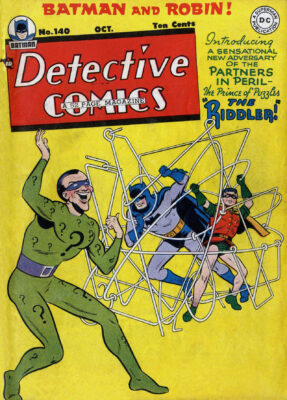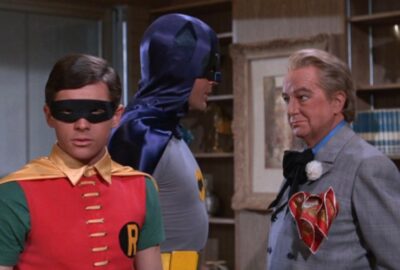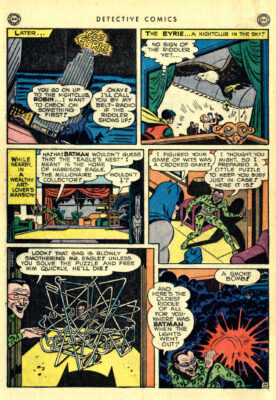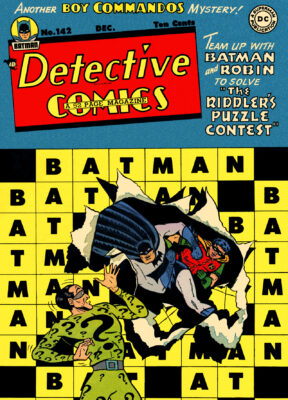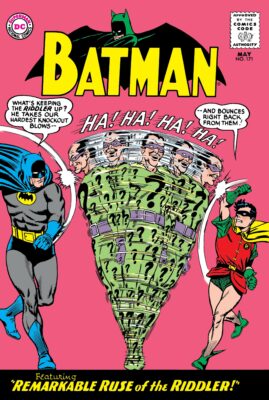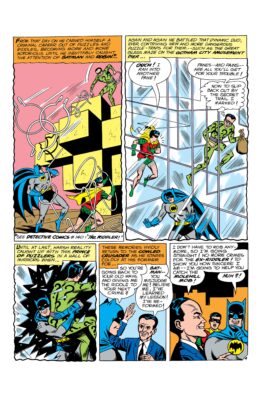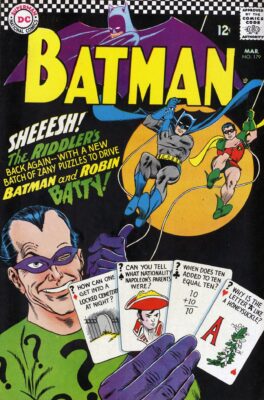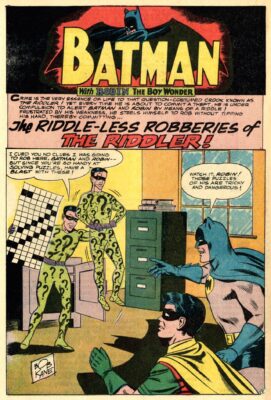When Does One Villain Have Two First Appearances? The Golden and Silver Age Debuts of The Riddler By Anthony M. Caro
Far more people discover superheroes and villains after watching movies and television shows than reading comic books. That’s not a new phenomenon, as the Batman television show likely introduced and defined characters to millions of viewers who never once paid a dime (literally) for an issue of Detective Comics. Live-action and animated programming could become more influential than anticipated, driving changes to a character in the books, for better or for worse.
For fans who enjoyed the Batman show during its original 1960s run and its 1970s/1980s syndicated glory years, Frank Gorshin was The Riddler. The actor’s portrayal gave an underdeveloped – but intriguing – villain a tremendous pop culture boost.
The Riddler appeared in print long before Gorshin took over the role. Still, no Batman book prominently utilized the villain until the comedian captivated audiences with his over-the-top performance. Paul Dano will soon have his turn interpreting The Riddler, and indications suggest he’s taking the character into dark territory, crafting a menacing and modern neo-film noir nemesis.
“Riddlers” change from generation to generation since the character’s publication history is somewhat in between A-list and B-list. He needs tweaks to stay relevant. You know what you’re getting with The Joker, as no one deviates too far away from established ways The Clown Prince of Crime behaves. While Joaquin Phoenix’s Joker takes the mad menace from the 1966 TV series and transports him to Mean Streets, he’s still The Joker.
The Riddler remains an open canvas for actors, writers, directors, and other artists to explore. Expect newer interpretations to experience further tweaks thanks to Matt Reeves’ The Batman. Reeves and Dano continue a trend, as Corey Michael Smith delivered a compelling and original acting take on Gotham.
“Tweaks,” however, are not complete re-imaginings, and the initial Golden and Silver Age tales established who and what the character is.
The First Riddles of the Golden Age
The Riddler debuted in Detective Comics #140 (October 1948) in an outstanding Golden Age morality tale, titled, appropriately, “The Riddler.” Writer Bill Finger, artist Dick Sprang, and inker Charles Paris crafted a story that holds up well today. Yes, the creative team produced a simple plot for a young audience, but their work never comes off as juvenile or condescending. The story hooks its intended audience with a unique villain who provides an interesting contrast to the book’s legendary hero.
The Riddler’s origin reveals his path to crime started in an unlikely place: a high school history class. The teacher offers a prize to anyone who can solve a history-themed jigsaw puzzle, and young Edward Nigma displays a willingness to cheat to win. And cheat and win, he does. “E. Nigma” also becomes obsessed with puzzles and logic games, sharpening his mind and deduction skills over time. Young Edward doesn’t like to lose, and “The boy who cheated on puzzles grew to be a puzzle expert…and still cheated!”
Seeing a way to profit from his skills, Edward starts running sleight of hand con games, making some nice cash the easy way. “But the small pickings of a carnival attraction do not satisfy the crooked puzzle master!”
Why didn’t they call The Riddler…The Puzzler? Maybe because he shifts focus from puzzles and hand tricks to telling riddles. Sure, the origin seems a little haphazard, but the morality lesson makes up for the not-always-perfect storytelling. Kids reading the story learned a few essential lessons about cheating. Small steps down an immoral path eventually lead to quantum leaps leading to dramatic consequences. You can only get away with con games and capers for so long. Someone’s watching, maybe The Batman.
The non-physically threatening villain proves more dangerous than anticipated for Batman. As with The Joker, Batman faces a homicidal foe who could never beat the Caped Crusader in a fight, but The Riddler has devious ways of trying to rid himself of the meddling hero. A calculating and evil mind puts the hero on defense, for sure.
Thankfully, Batman has some decent marbles upstairs. His deductive skills come to the rescue when brute force fails, and Batman thinks his way out of a deadly trap near the story’s conclusion. The action-packed finale presents another helpful lesson to its young readers: physical prowess isn’t enough to save the day. You have to have a sharp mind and an ethical one.
The Riddler’s first appearance brilliantly establishes him as a compelling rogue’s gallery character. Both selfish and lazy, he resorts to a crime spree to amass a comfortable fortune, and he’s not shy about committing murder to save his hide. The Riddler hardly comes off as a killer at the story’s beginning, but the theme that corruption slowly rots the soul shows where the path of thievery and conniving may take you.
The Riddler’s twisted mind and warped riddles depict him as the anti-anti-Joker. The Joker’s anarchistic mental state makes him unpredictable and often irrational. The Riddler is more calculating and somewhat predictable. The trouble is, predicting he’ll send a riddle doesn’t mean the riddles are easy to solve. One sequence has Batman coming to the wrong conclusion after pondering a riddle (Not banquet. “Bank-wet.”)
Yes, The Riddler is a formidable foe. No surprise they brought him back quickly. What a shame they didn’t do as great of a job the second time around, though.
A Puzzling Encore Performance
When the Riddler holds up a piece of ham, starts to meow, and then hums a tune, leading Batman to deduce “Got ham + Meew + Hmmm” = “Gotham Museum,” the creative team probably wasn’t putting too much effort or thought into the story.
Marvel Comics rose to publishing prominence in the 1960s, in part, as a reaction to some of the more simplistic books produced by the distinguished competition. Not all the criticism is fair, as National Periodicals/DC skewed younger and the company delivered age-appropriate stories. Marvel tried a new wave approach targeting older readers DC couldn’t keep. The strategy was not too far removed from how Entertaining Comics released adult-oriented and compelling crime, horror, suspense, and science-fiction that maintained an older readership.
Still, National Periodicals/DC fell victim to poor editorial quality control at times, and books suffered. As well done as the first Riddler story was, the villain’s second appearance seems like a sloppy rush job.
Detective Comics 142 (December 1948) brings The Riddler right back, and when he’s not stealing money, he’s coming up with a puzzle contest giving people a chance at winning prizes. The story’s title, “Crime’s Puzzle Contest,” sets the reader up for a lame premise: The Riddler’s contest will confuse people, and the villain will steal things while everyone’s confused. Fine.
When not plotting weird crime sprees, The Riddler wastes time giving Batman, Robin, and the public at large riddles and puzzles to solve. He did take the time to secretly jigsaw a floor that collapses on Batman and Robin without warning or logic. It’s one thing to write for a younger audience, but it’s another thing to care little about their literacy or intelligence.
The story took a cool villain and put him in a gimmicky throwaway story. Maybe reader reaction was tepid because even with the Caped Crusader appearing regularly in Batman, Detective Comics, and World’s Finest, The Riddler did not return to print for 17 years.
The Shadow of the Batman 1966 TV Show
“Is The Riddler playing games with Batman? Has he really gone straight – or is it all part of some crooked scheme?” asks writer Gardner Fox. (Spoiler Alert: It’s some crooked scheme.)
Someone at 20th Century Fox liked The Riddler, which is why the long-forgotten character got the nod to appear in the Fox/ABC Batman television series. While Frank Gorshin’s debut didn’t air until February 16, 1966, with the episode “A Riddle a Day,” editor Julius Schwartz and the creative teams knew The Riddler was coming to prime time, so they brought him back in Batman 171 (May 1965). “The Remarkable Ruse of the Riddler” featured the character’s first Silver Age appearance in an excellent story.
Seventeen years is a long time for a villain to sit on the sidelines. Even in “comic book time,” enough years passed that Batman and Robin don’t even recognize The Riddler when he gets out of jail! The Riddler takes advantage of the then non-cynical Batman’s good nature, as the Caped Crusader and the Boy Wonder give an older Edward Nigma the benefit of the doubt. After all, the parolee wants to help the Dynamic Duo defeat the thieving Molehill Mob. Just let The Riddler put on the old costume once again, but this time he’s doing it for a good cause.
No, he’s not. The Riddler wants to get back into the crime game, and he wants revenge on Batman and Robin. His genius-level intelligence and OCD riddle skills come together as a perfect way to taunt the heroic team. The Riddler wants to keep them guessing about whether he’s given up a life of crime, and several elaborate riddles and plans lead Batman and Robin to look pretty foolish upon “falsely” concluding The Riddler returned to his wayward life.
The character’s third appearance lacks any influence from Frank Gorshin’s interpretation. Understandable. The Batman TV show and Gorshin’s first portrayal wouldn’t hit prime time for several more months. So, the Silver Age “Prince of Puzzlers” stays true to the unethical and obsessive mindset crafted initially in his first appearance.
The Riddler’s the prototypical swerve artist always working some kind of angle. Give him a second chance after serving prison time, and he returns to form – the cheating high school student who never grew up and learned no lessons and unable to stay out of trouble. Why stay out of trouble? He’s smarter than everyone and always a step ahead. It’s not like he’s going to get caught, as villain logic goes.
The early version of the oddball nemesis lacks the Arkham Asylum criminally insane motivations of depictions soon to come. In his Silver Age arrival, he’s three-card Monte and a shell game squeezed in the whatever substituted for spandex in 1965. Maybe young kids need to learn about such connivers on comic book pages before running into them in real life.
Adults shouldn’t let their guard down, either. Batman and Robin do, and they almost pay a heavy price. There’s a tempered warning found in Batman and Robin’s decision to trust The Riddler. They know something’s not right, and the heroes have been around the block – via Bat-ropes – enough times to sense when someone’s being duplicitous. However, the heroes seem to acknowledge that people make mistakes and can turn their lives around. Perhaps subtle hints about forgiveness and compassion underscore the Dynamic Duo’s naivete while showing kids it’s not good to hold grudges. Being a Pollyanna about danger and shady people won’t help someone trying to live a long and healthy life serves as the other morality lesson here.
Arkham Days to Come
Writer Robert Kanigher, Penciller Sheldon Moldoff, and inker Joe Gialla produced “The Riddle-less Robberies of The Riddler” not long after the initial Silver Age appearance. Batman #179 boasts a cover date of March 1966, but it hit stands during January of 1966. The Riddler’s television launch was three weeks away, and Frank Gorshin’s performance did not impact the way Kanigher wrote the character, although the publication times perfectly with publicity the TV show would generate.
The television show’s effect on the story is visible in the company The Riddler keeps: a gang of thug helpers quick to use their fists. The television program’s villain-of-the-week always had a hapless gang of henchmen to serve as pugilist fodder during the trademark fight scenes. Neither The Riddler nor his crew comes off as campy in the comic story, as the tale stays true to the character’s initial development.
The odd plot does tinker with the very core of The Riddler and hints at the alter ego’s psychological troubles.
Batman and other National Periodicals/DC superhero books published circa ‘65 and ‘66 weren’t always known for their depth and subtext. Still, the thematic seeds for future character development arrive with the overt acknowledgment that an obsession with telling riddles when engaged in a crime spree is not typical behavior. Even The Riddler has the self-awareness to realize his obsessive-compulsive behavior may need adjusting. He has no intention of giving up his life of crime, but he wants to go about things in a slightly more normal way.
Borrowing from DC Comics’ future, the villain’s decision to drop the shtick leads to an identity crisis. How can he be The Riddler and not tell riddles?
“I just can’t bring myself to give up robberies…But can I really prevent myself from handing out those riddles?” Apparently not because The Riddler cannot physically commit the act of stealing anything unless he precedes the crime with a riddle. Unless he leaves a riddle beforehand, The Riddler suffers crippling carpal tunnel syndrome rendering his thieving fingers useless! Realizing that “understanding” his “faults and weaknesses” is the key to overcoming his dysfunction, The Riddler decides to become his own personal psychoanalyst. Try as he might, The Riddler accepts that he’s psychologically addicted to combining crimes with riddles and figures future success involves telling better ones.
What does telling riddles have to do with committing crimes, though? The character never truly stumps Batman, and the riddles typically give his plans away. Maybe The Riddler doesn’t care about stumping Batman nor even getting away with his crimes. The prime goal might involve proving his intellectual superiority, a common theme among super-villains. While not as overt as Lex Luthor in his fishing for compliments “proving” his intellectual superiority, The Riddler has the inferiority complex that drives his “See how smart I am?” behavior.
Like many fictional characters focused on proving their brilliance, The Riddler reveals an inferiority complex. As with many members of the Batman Rogues Gallery, the “puzzling prince” suffers from low self-esteem and self-doubt. His riddling would underscore unhinged and dangerous behavior in subsequent years, making him more suited to Arkham Asylum than Blackgate Prison.
The Riddler of the Ages
The Batman television show’s popularity skyrocketed into Bat-mania but crashed quickly. Camp humor only has so many legs before audiences grow tired. The Riddler rode the TV show’s popularity to a handful of appearances in the Silver Age, ending with Detective Comics #377 bearing a cover date of July 1968. The television series presented its last first-run broadcast on March 14, 1968. The Riddler disappeared from the comics until 1975 when Batman #260 (January 1975) reprinted Detective Comics #377. The late 1970s saw The Riddler receive more stories, likely thanks to the television series becoming incredibly popular in syndication.
The Bronze Age and the Modern Age feature several versions of The Riddler. Post-Crisis, Post-Zero Hour, and alternate universe versions may come with their spins. Different writers may present the Prince of Puzzlers to fit their visions.
Ultimately, whatever anyone comes up with is a variation on the villain first appearing in Batman #140. Frank Gorshin included.
Anthony M. Caro wrote the essay collection Universal Monsters and Neurotics: Children of the Night and their Hang-Ups and the sci-fi serial Why Does Cal Draw Stick Figures at 3 AM in the 22nd Century? for Amazon Kindle. He writes about all things pop culture and contributed to HorrorNews.Net, PopMatters, Mad Scientist, and Jiu-Jitsu Times. Besides working as a professional writer, he handled production duties in radio, TV, film, and theater. He’s currently developing an audio drama podcast.
essay ©2023 Anthony Caro
Join us for more discussion at our Facebook group
check out our CBH documentary videos on our CBH Youtube Channel
get some historic comic book shirts, pillows, etc at CBH Merchandise
check out our CBH Podcast available on Apple Podcasts, Google PlayerFM and Stitcher.
Use of images are not intended to infringe on copyright, but merely used for academic purpose.
Images used ©Their Respective Copyright Holders










